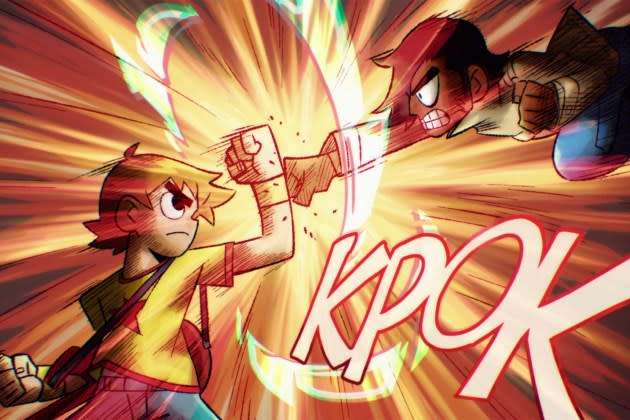‘Scott Pilgrim Takes Off’ Review: Netflix’s Animated Adaptation Charms Despite Flaws

Even if you’ve read Bryan Lee O’Malley’s seminal Scott Pilgrim Oni Press graphic novel series and even if you’ve seen Edgar Wright’s 2010 live-action Scott Pilgrim vs. the World, O’Malley and BenDavid Grabinski’s new Netflix animated series Scott Pilgrim Takes Off isn’t what you’re expecting it to be.
Because of Netflix’s very restrictive requests regarding what critics can and cannot reveal about Scott Pilgrim Takes Off, I can’t tell you how or why it’s different or what the differences do to the themes of O’Malley’s fantastical story. Heck, I can’t even tell you if there are guest stars, much less who they are or who they play.
More from The Hollywood Reporter
'Leo' Review: Adam Sandler Is an Advice-Dispensing Lizard in Netflix's Animated Charmer
Edgar Wright Talks the Long Road to 'Scott Pilgrim Takes Off' and the Key to Franchise Storytelling
Darn.
So to boil it down: Scott Pilgrim Takes Off is probably my third favorite incarnation of this story, and I don’t think the reconfiguration of the story entirely works, but it’s so full of relentless charm that the diminishing returns only occasionally bothered me.
So what can I tell you while still abiding by the Draconian Do Not Reveal list?
Well, Scott Pilgrim Takes Off may not be what you’re expecting it to be, but that isn’t instantly the case.
The set-up is identical. Scott Pilgrim (Michael Cera) is a shiftless Toronto twentysomething crashing with his gay best friend (Kieran Culkin’s Wallace Wells) and dating a high-school student (Ellen Wong’s Knives Chau) in a way that’s both creepy and entirely chaste, so it isn’t TOO creepy. Scott isn’t dating a high-school student for some gross reason. He’s just emotionally damaged after a failed relationship with a suddenly famous rock star (Brie Larson’s Envy Adams).
Scott’s own musical ambitions are slightly lower, but he plays the bass in the fledgling band Sex Bob-omb with Stephen Stills (Mark Webber) and Kim Pine (Alison Pill), an ex-girlfriend.
He’s generally adrift.
Then he meets Ramona Flowers (Mary Elizabeth Winstead), the purple-or-pink-or-blue-or-green-haired girl of his dreams. Literally. She rollerblades through his dreams as part of her job delivering DVDs for Netflix. Well, not his dreams. Scott has a really convenient subspace highway running through his head. Scott and Ramona flirt cutely, but their budding romance becomes complicated by the arrival of the first of her seven evil exes, a legion Scott has to conquer before love can bloom.
So far, you’re like, “Yes. That’s the comic. And the movie. Even if she’s now delivering for Netflix and not Amazon.” But what if I told you that when Scott is hitting on Ramona, he now mentions Sonic the Hedgehog instead of Pac-Man? Totally different, right?
Anyway, at some point that I can’t reveal, things get different. For O’Malley, with Grabinski, it’s another opportunity to explore and underline the story’s themes concerning ways new relationships are invariably haunted by the fact that both participants have pasts they aren’t necessarily prepared to move, well, past. It’s still a celebration of anime, video games and Canada, though it somehow manages to add even more levels of meta humor.
Without spoiling much, the new approach spreads out the focus, but in making the story less exclusively Scott Pilgrim’s — backstories and subplots galore! — it becomes much more a series of wacky genre hybrid hijinks without a stable center. It works well conceptually and it’s spotty in execution, but at least there’s a lot of concept. Probably too much concept, and this was already a story that was a LOT of concept.
I understand feeling like the character of Scott can come across as an insufferable man-child and not wanting to hang the entire story on him, but I always found the annoyance generated by Scott to be a feature, not a bug. He’s supposed to be a fetus. And Ramona is supposed to be a fetus, albeit a wiser one. They’re all the more relatable for that. It’s still a love story, even if it’s a love story in which you think the main couple is probably destined for disaster. In this interpretation, the pacing and character work feel less persuasive at every turn, and the love story feels barely relevant because there’s so much other stuff happening.
Fortunately, however diffuse the story is, the other stuff happening is frequently delightful, starting with the animation provided by Science Saru and directed by Abel Góngora. It looks and feels exactly like O’Malley’s books look and feel, which is hugely satisfying, while at the same time being a less dazzling feat of imagination than the magic Wright was able to achieve in the movie. The series lets the surprises come from the story instead of from the way the wonder is being achieved. While I might prefer the latter, they both have merit. Here, it’s all vibrantly colorful and the energy is tremendously boosted by the music by Joseph Trapanese and Anamanaguchi and a properly kick-ass soundtrack starting with “Bloom,” the opening titles song by Necry Talkie.
And, more than anything, Scott Pilgrim Takes Off is a reminder of the off-the-charts casting job done on the movie and transplanted vocally. I still love Cera’s callow youthfulness, Winstead’s smoky cool-girl maturity, Culkin’s pre-Roman snark, Pill’s cutting sarcasm, Chris Evans’ gruff movie-star machismo, Brandon Routh’s himbo vegan bluster and, especially, Wong’s untethered youthful enthusiasm.
Oh, and there are guest stars. But they’re a SECRET. (They’re also not mind-blowing or anything. They’re just fun. That’s basically my review of the entire series. It isn’t mind-blowing. But it’s fun.)
So maybe Scott Pilgrim Takes Off isn’t what you expect it to be and maybe that’s both positive and negative and maybe this will never be my favorite version of this world, but there’s much to enjoy in these eight fast-moving episodes.
Best of The Hollywood Reporter

